Fine Coins Showcase
Antiquities Showcase
Show Empty Categories
Shop Search
Shopping Cart
My FORVM
Contact Us
About Forum
Shopping at Forum
Our Guarantee
Payment Options
Shipping Options & Fees
Privacy & Security
Forum Staff
Selling Your Coins
Identifying Your Coin
FAQs
zoom.asp
Home ▸ Catalog ▸ |Members Auction Listed||View Options:   | | | | | | The following coins, antiquities, books, catalogs and supplies are listed on the FORVM Members' Auction. The Members' Auction is a budget auction with all items starting at $5.00. There are NO buyers fees. The Members' Auction is a no snipe auction. If you bid near the end of the auction, the time to close will be extended two hours. Click on the link with the hammer to see the current price and to bid. |
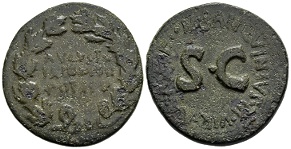

The wreath on the obverse is the corona civica, the oak wreath awarded to Roman citizens ex senatus consulto (by special decree of the Senate) for saving the life of another citizen by slaying an enemy in battle. It became a prerogative for Roman emperors to be awarded the Civic Crown, originating with Augustus, who was awarded it in 27 B.C. for saving the lives of citizens by ending the series of civil wars.MA114913. Orichalcum dupondius, RIC I 342, BMCRE I 197, Cohen I 521, SRCV I 1666, aF, green patina, porous, weight 8.323 g, maximum diameter 25.1 mm, die axis 45o, Rome mint, 17 B.C.; obverse AVGVSTVS / TRIBVNIC / POTEST, legend in three lines within oak wreath; reverse M SANQVINIVS Q F III VIR A A A F F, legend surrounding large S C; ; $40.96 (€38.50)
Macedonian Kingdom, Philip II of Macedonia, 359 - 336 B.C.
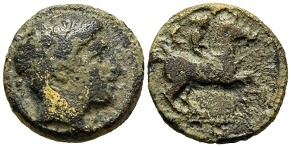

Philip II became the ruler of all Greece when he defeated the Athenians at the Battle of Chaeroneia in 338 B.C. Philip personally selected the design of his coins. His horse, on the reverse of this coin, won a race in the Olympic Games in 356 B.C., the year his son Alexander the Great was born.MA114394. Bronze AE 17, SNG Munchen 968, SNG ANS 962, SNG Alpha Bank 391 ff. var. (no obv symbol), SNG Cop -, F, weight 5.359 g, maximum diameter 17.5 mm, die axis 180o, Macedonian mint, 359 - 336 B.C.; obverse diademed head of Apollo right, A (control symbol) behind; reverse ΦIΛIΠΠOY, nude young male rider on horse prancing right, Π (control symbol) below; $40.00 (€37.60)
Elaia, Aeolis, c. 340 - 275 B.C.


Herodotus describes the following story relevant to the olive wreath. Xerxes was interrogating some Arcadians after the Battle of Thermopylae. Asked why there were so few Greek men defending the Thermopylae, they answered, "All other men are participating in the Olympic Games." And when asked "What is the prize for the winner?", "An olive-wreath" came the answer. Then Tigranes, one of his generals uttered a most noble saying: "Good heavens! Mardonius, what kind of men are these against whom you have brought us to fight? Men who do not compete for possessions, but for honor."MA115024. Bronze AE 11, cf. SNG Cop 169; SNGvA 1605; SNG Munchen 386; SNG Tübingen 2685; BMC Troas p. 126, 11, aF, weight 1.569 g, maximum diameter 10.9 mm, Elaia (near Zeytindag, Turkey) mint, c. 340 - 275 B.C.; obverse head of Athena left in Corinthian helmet; reverse Ε - Λ either side of grain kernel, the whole within olive wreath; from Shawn Caza, former diplomat, author of A Handbook of Late Roman Coins (Spink, 2021), collection assembled during postings and international travel; ex Dorotheum (Vienna, Austria); $40.00 (€37.60)
Mylasa, Caria, c. 420 - 390 B.C.


Mylasa was often mentioned by ancient writers. The first mention is from early 7th century B.C., when Arselis, a Carian leader from Mylasa, helped Gyges in his fight for the Lydian throne. Under Persia, Mylasa was the chief city of Caria. Mylasa joined the Delian League c. 455 B.C., but Persian rule was restored by 400. Mylasa was the hometown and first capital of the Hecatomnid dynasty, nominally Persian satraps, but practically kings of Caria and the surrounding region, 377 - 352 B.C. In the Hellenistic era, the city was contested by Alexander's successors, but prospered. Mylasa was severely damaged in the Roman Civil War in 40 B.C., but again regained prosperity under Roman rule.GA115020. Silver tetartemorion, SNG Kayhan 944, HN Online T977, weight 2.047 g, maximum diameter 6.3 mm, Mylasa (Milas, Turkey) mint, c. 420 - 390 B.C.; obverse lion forepart left, head turned back right, roaring; reverse bird standing right, two pellets - upper left and lower right, all in incuse square; from Shawn Caza, former diplomat, author of A Handbook of Late Roman Coins (Spink, 2021); ex Dorotheum (Vienna, Austria); rare; $38.00 (€35.72)
Neandria, Troas, c. 4th Century B.C.


In the 5th century B.C. Neandreia was a member of the Delian League. Probably following the defeat of Athens in the Peloponnesian War in 404, Neandreia came under the influence of Zenis, the dynast of Dardanus, who controlled the Troad on behalf of the Persian satrap Pharnabazos. Under Zenis and his wife and successor Mania, a garrison of Greek troops was installed in Neandreia. In 399 B.C., this garrison was expelled and the city freed by the Spartan commander Dercylidas. In the late 5th or early 4th century B.C. a new circuit of walls was constructed. Later in the 4th century B.C. there was further construction including housing on a rectangular grid, a complex internal drainage system, and possibly a theater. The excavators estimate that in this period the city consisted of 230 houses and a population of about 2,500 individuals. About 310 B.C., Antigonus I Monophthalmus founded Antigonia Troas (after 301 B.C. renamed Alexandria Troas) as a synoecism of the surrounding cities of the Troad, including Neandreia. The earliest coinage of the new city adopted the coin types of Neandreia, which displayed a grazing horse, and this remained Alexandria Troas' emblem on its coinage for the rest of antiquity. From this point on, Neandreia had no independent political existence, hence in the 1st century A.D. Pliny the Elder listed it among the settlements in the Troad which no longer existed in his day.GB115023. Bronze AE 10, SNG Arikantürk 692 ff.; SNG Munchen 295 f.; SNG Ashmolean 1175; SNG Cop 449; SNG Tübingen 2652; SNGvA 1557; SNG Tanrikulu 348; BMC Troas p. 73, 4, F, olive green patina, pitting, weight 1.238 g, maximum diameter 10.4 mm, Neandria (Çigri Dag, Turkey) mint, c. 4th Century B.C.; obverse laureate head of Apollo right; reverse barley grain in center, NEAN upward on left, bunch of grapes on right; from Shawn Caza, former diplomat, author of A Handbook of Late Roman Coins (Spink, 2021), collection assembled during postings and international travel; ex Dorotheum (Vienna, Austria); $38.00 (€35.72)
Macedonian Kingdom, Philip II of Macedonia, 359 - 336 B.C.
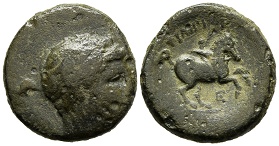

Philip II became the ruler of all Greece when he defeated the Athenians at the Battle of Chaeroneia in 338 B.C. Philip personally selected the design of his coins. His horse, on the reverse of this coin, won a race in the Olympic Games in 356 B.C., the year his son Alexander the Great was born.MA114393. Bronze AE 19, SNG Alpha Bank 377, SNG Cop 585, SNG ANS 915, F, green patina, scattered small pits, obv. off center, weight 5.945 g, maximum diameter 18.7 mm, die axis 0o, Macedonian mint, c. 323 - 315 B.C.; obverse Apollo, head right wearing taenia; reverse ΦIΛIΠΠOY, naked male youth on horse pacing right holding palm, E under horse's belly; $35.00 (€32.90)
Kingdom of Sicily, Manfred von Hohenstaufen, 1258 - 1266
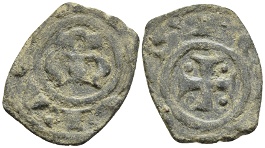

Manfred was frequently in conflict with the Papacy and was excommunicated by three different popes. In the Divine Comedy, Dante meets Manfred outside the gates of Purgatory, where the spirit explains that, although he repented of his sins in the moment of death, he must atone by waiting 30 years for each year he lived as an excommunicate, before being admitted to Purgatory proper. Queen Elizabeth is a descendant of King Manfred. ME95082. Billon denaro, Spahr 217, MEC Italy III 621, MIR 10 485 (R, Brindisi), Travaini 82, Thomsen 2513, gF, well centered on a typical small squared flan, earthen encrustation, light cleaning scratches, weight 0.774 g, maximum diameter 16.1 mm, Messina mint, obverse + DEI GRACR, Ω over M; reverse + • SICILIE •, cross pattée with pellet in each quarter; $30.00 (€28.20)
Kingdom of Sicily, Manfred von Hohenstaufen, 1258 - 1266
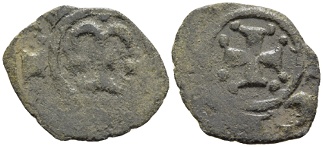

Manfred was frequently in conflict with the Papacy and was excommunicated by three different popes. In the Divine Comedy, Dante meets Manfred outside the gates of Purgatory, where the spirit explains that, although he repented of his sins in the moment of death, he must atone by waiting 30 years for each year he lived as an excommunicate, before being admitted to Purgatory proper. Queen Elizabeth is a descendant of King Manfred.ME95094. Billon denaro, Spahr 211, MIR Sicilia 140 (R), MEC Italy III 614, Travaini 78, F, green patina, typical squared small flan, a little rough, edge ragged, weight 0.440 g, maximum diameter 14.9 mm, Messina mint, 1258 - 1266; obverse + MAYNF R, tau between three pellets, one above, one on each side; reverse + SICILIE, Cross pattée with a pellet at at each corner of end of the arms; scarce; $30.00 (€28.20)
Macedonian Kingdom, Philip II of Macedonia, 359 - 336 B.C.
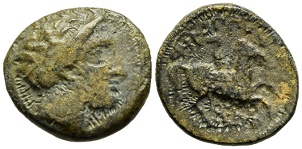

Philip II became the ruler of all Greece when he defeated the Athenians at the Battle of Chaeroneia in 338 B.C. Philip personally selected the design of his coins. His horse, on the reverse of this coin, won a race in the Olympic Games in 356 B.C., the year his son Alexander the Great was born.MA114389. Bronze AE 17, weight 3.913 g, maximum diameter 17.2 mm, die axis 0o, Macedonian mint, 359 - 336 B.C.; obverse diademed head of Apollo right, A (control symbol) behind; reverse ΦIΛIΠΠOY, nude young male rider on horse prancing right, obscure control symbol (fulmen?) below; $30.00 (€28.20)
Kingdom of Thrace, Rhoemetalces I, c. 11 B.C. - 12 A.D., Augustus Reverse


When the Cotys VII, King of Thrace, died about 48 B.C. Rhoemetalces I became the guardian of his nephew Rhescuporis I, his brother's young son and heir. In 13 B.C., Rhescuporis I was defeated and slain in battle by Vologases, chief of the Thracian Bessi, who was leading a revolt against Rome. As Rhescuporis I had left no heir, Rhoemetalces became king. An ally of Augustus, the Roman Historian Tacitus described Rhoemetalces as attractive and civilized. After his death, Augustus divided his realm, half for his son Cotys VIII and the other half for Rhoemetalces' brother Rhescuporis II. Tacitus states that Cotys received the cultivated parts, most towns and most Greek cities of Thrace, while Rhescuporis received the wild and savage portion with enemies on its frontier.RP115033. Bronze AE 23, Youroukova 204; RPC I 1711; SNG Cop 1188; SNG Tübingen 972; BMC Thrace p. 209, 4; Weber 2743, Fair, weight 4.534 g, maximum diameter 17.3 mm, die axis 0o, c. 11 B.C. - 12 A.D.; obverse BAΣIΛEΩΣ POIMHTAΛKOY, jugate heads of Rhoemetalces I, diademed, and Queen Pythodoris right; reverse KAIΣAPOΣ ΣEBAΣTOY, bare head of Augustus right; from Shawn Caza, former diplomat, author of A Handbook of Late Roman Coins (Spink, 2021), collection assembled during postings and international travel; ex Dorotheum (Vienna, Austria); $26.00 (€24.44)
CLICK HERE TO SEE MORE FROM THIS CATEGORY - FORVM's PRIOR SALES



Page created in 1.563 seconds.







